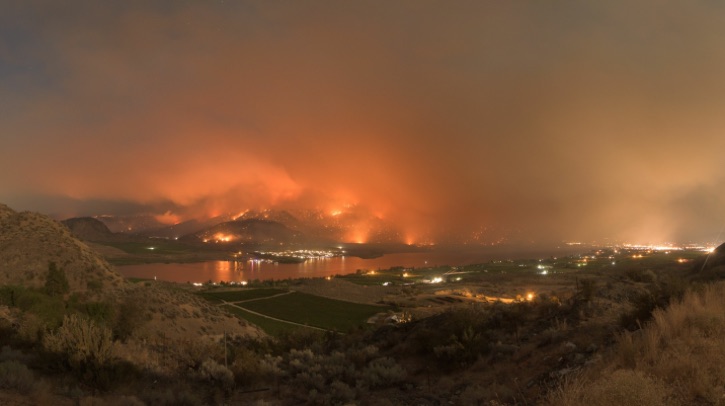In the lead-up to Canada’s increasingly extreme wildfire season, Ramla Qureshi, an assistant professor in McMaster University’s Department of Civil Engineering, explores how cutting-edge meteorological technology is influencing the future of climate-adaptive cities.
 How do extreme weather events, such as wildfires and hurricanes, affect your work and the structural integrity of buildings and infrastructure?
How do extreme weather events, such as wildfires and hurricanes, affect your work and the structural integrity of buildings and infrastructure?
Thermal expansion and contraction occur in all materials as temperatures fluctuate. However, exposure to extreme heat, such as what can be expected in a structurally significant fire, induces plastic (or, in other words, irreversible) material degradation in non-combustible construction materials, such as steel and concrete, and can ignite combustible materials like wood.
Steel, for example, experiences a gradual reduction in mechanical strength beginning at approximately 400°C. This is followed by rapid deterioration, with most steels retaining only 20% or so of the ambient-temperature strength at 700°C. On the other hand, concrete, despite its excellent insulating properties, contains entrapped moisture within it, which turns into steam when exposed to high temperatures. The resulting vapor pressure often causes explosive spalling, severely compromising structural integrity. Structural timber, as a combustible material, exhibits interesting thermal behavior under fire. At around 100°C, any unbound moisture evaporates. Thermal softening usually begins at approximately 180°C, peaking around 320°C as lignin and cellulose begin to disintegrate. This process occurs earlier in moist wood, with softening commencing near 100°C. The ignition temperature of wood varies based on exposure duration but typically is within the 250°C to 300°C range. Once ignited, the material undergoes pyrolysis, forming a protective char layer at an approximate rate of 0.8mm per minute.
Fully developed compartment fires in residential structures commonly reach temperatures ranging from 500°C to 900°C. Typically, most single-family homes in North America are wood-framed structures, with minimal fire resistance ratings. So, when wildfires breach city boundaries, the tiniest of embers can ignite entire buildings, and high winds can spread flames in a turbulent manner across urban areas. In a perfect storm – for instance, the recent Palisades fires in LA – such extreme conditions rapidly deteriorate the load-bearing capacity of both structural and non-structural elements and ease the path for overall fire-induced collapse mechanisms.
Can you discuss the role of meteorological technology and data in predicting and mitigating the effects of extreme weather on urban structures?
There is a lot of very useful geographic information systems (GIS) and remote sensing technology out there for this. Numerical weather prediction (NWP) models, together with radar- and satellite-based Earth observation systems, track wildfires, floods, tornadoes and other atmospheric disturbances. These are usually the alarm bells that help emergency decision-makers and first responders in enabling evacuations and infrastructure protection. On the research side of things, historical climate patterns help us figure out the risk of exposure and urban vulnerability to extreme events.
However, when it comes to protecting the built environment, we must go back to basics: we must design structures to be resilient to site-specific hazards. For example, if we’re building in forest land where there is a probability of wildfire, structures within this wildland urban interface (WUI) should be constructed to withstand the effects of fire. This, of course, requires data-driven and risk-averse models of what an expected design hazard can be, accounting for the rapidly changing weather patterns, which is where meteorological technology really comes into play.
How important is the collaboration between meteorologists, engineers and urban planners in addressing the challenges posed by extreme weather?
Extremely! Meteorologists provide precise (or as precise as can currently be) forecast models, urban planners use these forecasts to map out exposure risks and implement zoning and land-use strategies, and structural engineers use all this information, along with material innovation, to develop climate-adaptive buildings.
What advances in meteorological technology have had the most significant impact on improving structural resilience against extreme hazards?
High-resolution satellite imagery is extremely useful. Currently, the freely available satellite images have a spatial resolution of approximately 1px for every 10-60m. Most structures within the WUI average between 16m and 25m. So there is potential for information loss if low-resolution imagery is used.
That said, satellite imagery rarely gives data on real-time fire spread, as two images of the same fire are often separated by a few hours. Drones capturing real-time images for the early detection of environmental hazards can be very helpful here. Other than that, anything that improves weather prediction, particularly the weather research and forecasting (WRF) NWP models, are very useful. For example, in the case of WUI fires, fire weather predictors with forecasting tools that predict hourly risk and overall fire weather indices are very helpful.
What are the current gaps in research that need to be addressed to better understand and mitigate the impacts of extreme weather on structures? What technological solutions would better support your work?
Existing building design codes rely on deterministic, empirical data that doesn’t necessarily capture the stochastic variability of climate change. We need better climatic and wind hazard models, especially for WUI fires, where changing terrain patterns make wind and fire spread erratically. We need more real-time and accessible data that is site-specific and temporally recent. As structural engineering researchers, we are already working on uncertainty quantification of material behavior under prolonged extreme conditions. Real-time, sensor-based structural health monitoring systems that use IoT and AI for adaptive maintenance are revolutionizing structural and infrastructure resilience. However, much of this technology is still nascent and often doesn’t look at the lifecycle of a structure with all its wear and tear, as well as extreme events, holistically.
How can data from meteorological technologies be integrated into urban planning to enhance the resilience of cities against extreme weather events?
I think the answer to this is a multiscale endeavor. At the immediate operational level, real-time sensors and IoT devices deployed throughout a city to continuously monitor weather conditions and structural performance can enable automated alerts for evacuation and immediate life safety responses during sudden extreme events.
Over day-to-day operations, data from these sensors supports maintenance and structural health monitoring of critical infrastructure, ensuring that wear and damage from prolonged exposure to severe weather are addressed on time. On a strategic scale, high-resolution, long-term meteorological data can be fed into GIS-based hazard maps and digital twin simulations and help us identify risk hotspots and bottlenecks, adjust zoning regulations, update building codes and design adaptive infrastructure.
What are the key challenges in designing structures that can withstand both seismic activity and extreme weather conditions?
Most building codes and design methodologies prioritize ductility-based design for seismic forces, which banks on energy dissipation through planned damage on select ductile elements, or ‘fuses’, within a structure. On the other hand, hurricanes or windstorms demand stiffness to minimize uplift and lateral pressure. Designing for structural fire protection requires material iterations, which in turn can add to or subtract from the overall structural weight demands. Added to this situation are the many uncertainties in hazard intensity and frequency, which require designers to adopt adaptive, performance-based approaches and incorporate advanced modeling and sensor data to refine both seismic and extreme weather load predictions.
For more of the top insights into the key meteorological technologies keeping people and infrastructure safe, read Meteorological Technology International’s exclusive feature, How are the latest early warning technologies protecting against devastating hurricanes?, here.



